SUPERCONVERSATIONS DAY 45: MANUEL CORREA RESPONDS TO DÉBORAH DANOWSKI & EDUARDO VIVEIROS de CASTRO, “IS THERE ANY WORLD TO COME?”
#Us without the world, or the world without us?
Paolo Uccello, The hunt in the forest, 1470.
For Viveiros de Castro and Danowski, the scenario is proposed by Amerindian cosmologies (Aikewara, Yawanawa, Yanomami): “The myth’s action takes place in a time in which ‘nothing yet was, but people already existed’. In effect, in these cosmogonies, humans are the precursors of everything, often transforming themselves into flora and fauna, canoes and rivers.
What we could call the natural world, or ‘world’ for short, is for Amazonian peoples a multiplicity of intricately connected multiplicities. Animal species and other species are conceived as so many kinds of ‘people’ or ‘peoples’—that is, as political entities. It is not ‘the jaguar’ that is ‘human’; it is individual jaguars that take on a subjective dimension (more or less pertinent according to the practical context of interaction) when they are perceived as having a society ‘behind’ them, a collective political alterity. To be sure, we too – by which we mean we Westerners, a concept that includes, through mere convention, Brazilians of European descent – think, or would like to think that we think, that it is only possible to be human in society, that man is a political animal etc. But Amerindians think that there are many more societies (and therefore also humans) between heaven and earth than have been dreamt by our philosophy and anthropology.
While Viveiros de Castro and Danowski’s colorful conclusion might encourage us to find the specific through our encounter with the other, these “undreamt” societies and their interactions with one another have been rigorously studied in the West by the 19th century discipline of ecology. Ecology had enormous trouble in its early years to achieve a worldview resonant with Viveiros de Castro and Danowski’s Amerindians; Westerners were too invested in the discrete and digital to be able to grasp that the world was in fact an ecosystem articulated by the relationships of a myriad of natural objects -fauna, flora, etc-, fragile and changing, riven in appearance, but immanent to the core… then:
. . . on Christmas Eve of 1968, when the Apollo 8 went around the dark side of the moon and emerged to see, for the first time in human history, not a sunrise or a moonrise but an earthrise, and in that brilliant moment of illumination we realized that the earth was not this infinite flat sphere, but in fact a blue planet, as the astronauts famously said: “veiled in cloud, floating in the velvet void of space.” That moment sparked a rebooting of the human imagination, and since then, much has changed. You can’t necessarily point to that moment as being the cause of any of these changes, but it created a whole new sense of the environment. Before the moon shot, getting people to stop throwing garbage out of the window of a car was considered a great environmental victory. Nobody spoke of biodiversity, nobody spoke of the biosphere, nobody had any conscious sense that there was an interwoven, interconnected web of life that surrounded the planet, nobody was aware of the fragility of the planet.
– Wade Davis
Representation
To consider our difficulty of conceiving the world as an extended topological surface which includes us, we will refer to the digital conception of the world as a group of discrete entities, as it is palpable in early European painting. In Paulo Uccello’s The Hunt in the Forest (1470), we can note without doubt that the painter saw each individual hunting dog at different times and collaged his drawings to form a composition. Each figure appears to float, decreasing in size via perspective, but never altering the topological surfaces that surround it. When an early Renaissance painter depicted a face, he was prey to his cognitive bias: “this is a nose” so he painted a nose, then a mouth, then eyes. In later painting, figures like Diego Velasquez were conscious that those divisions were in fact imaginary, and that in order to naturalistically depict a face, one must abandon them and instead favor the rendering of undivided surfaces.
Natural objects as subjected to alterity
Traditionally, in our Western mytho-philosophical tradition, we conceived the world as an agglomeration of differences into a unifying structure that excludes us, (or conveniently places us at the apex of its pyramid). Natural objects are, like other humans, subject to alterity. If we accept this proposal, we can then either perceive X natural object as different/ equal / distant. To follow Tzvetan Todorov’s logic: Perceiving tortoises as Other immediately introduces axiological value judgements (i.e: Are tortoises equal to me or inferior?). Perceiving them as equal leads to in-difference, whilst perceiving them as inferior leads to value superimposition (we assume our control over them.)
Genesis 1:28. And God blessed them, and God said to them, Be fruitful, and multiply, and replenish the earth, and subdue it: and have dominion over the fish of the sea, and over the fowl of the air, and over every living animal that moveth upon the earth.
Can we truly embrace the great lesson of ecology, namely, that we are part of a complex array of vulnerable systems, without sparking another reboot in our imaginary cosmogonies? Is representation partly to blame for presenting the world as a digital rendering (everything in it is discreet and divided) instead of a tableaux formed by a multiplicity of topological surfaces that overlap and alter our perception?
Manuel Correa is an artist and filmmaker from Colombia. He is the director of the upcoming documentary #artoffline
